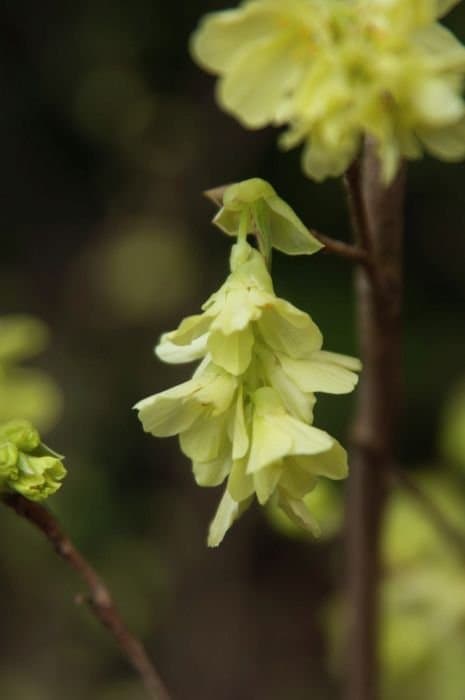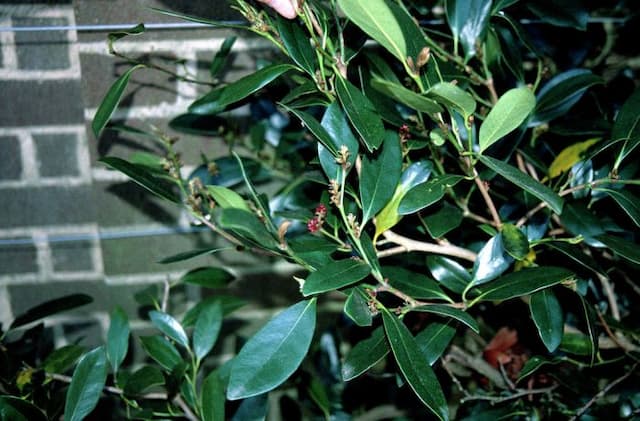Witch Hazel Hamamelis × intermedia 'Anne'

ABOUT
The plant referred to as 'Anne' is a cultivar known for its unique and attractive flowers. These blossoms are distinctive, showing off ribbon-like petals that are usually a vibrant yellow with reddish bases, giving the plant a striking bicolor appearance when in full bloom. The flowers emerge in late winter to early spring, providing a burst of color when the landscape is often still dormant. This specimen has a spreading habit with gracefully arching branches that add to its visual appeal. The foliage of the plant is equally beautiful, with broad leaves that often turn an attractive array of colors in the fall, ranging from yellow to red, before dropping. The leaves are typically oval with a wavy or slightly toothed edge, giving them an interesting texture. Overall, the plant presents a lovely display throughout the seasons, from the fragrant, spidery flowers of the colder months to the lush, green canopy of summer, then to the fiery tones of autumn.
About this plant
 Names
NamesFamily
Hamamelidaceae
Synonyms
Hybrid Witch Hazel, Witch Hazel 'Anne'
Common names
Hamamelis × intermedia 'Anne'.
 Toxicity
ToxicityTo humans
The hybrid witch hazel 'Anne' is generally not considered toxic to humans. It does not have a known history of causing poisoning when touched or ingested. However, as with any plant, individual allergic reactions or sensitivities could occur, so it's always prudent to handle plants with care and avoid ingesting plant material that is not meant for consumption.
To pets
The hybrid witch hazel 'Anne' is also not known to be toxic to pets. It is rarely reported to cause any adverse effects if pets come into contact with or ingest parts of the plant. Nevertheless, pet owners should always be cautious and prevent pets from eating ornamental plants as a general safety precaution, as individual animals may react differently.
 Characteristics
CharacteristicsLife cycle
Perennials
Foliage type
Deciduous
Color of leaves
Green
Flower color
Yellow
Height
8-12 feet (2.4-3.7 meters)
Spread
10-15 feet (3-4.6 meters)
Plant type
Shrub
Hardiness zones
5
Native area
Asia
Benefits
 General Benefits
General Benefits- Attractive Winter Blooms: Produces vibrant yellow to red flowers that add color to the garden during the dull winter months.
- Seasonal Interest: Offers year-round interest with flowers in winter, lush green foliage in spring and summer, and colorful leaves in autumn.
- Wildlife Habitat: Provides food for pollinators such as bees when little else is in bloom.
- Durable and Hardy: Tolerates a variety of soil types and conditions, making it a resilient choice for many landscapes.
- Low Maintenance: Requires minimal care once established, making it suitable for gardeners of all skill levels.
- Architectural Structure: Can be used as a focal point in garden design due to its unique form and branching structure.
- Screening and Privacy: Can grow to a substantial size, making it useful for screening views or providing privacy in a garden setting.
- Foundation Planting: Because of its moderate size and attractive form, it's often used for planting near buildings or homes.
- Seasonal Fragrance: The flowers are often fragrant, providing a pleasant scent in the landscape during its blooming season.
 Medical Properties
Medical PropertiesThis plant is not used for medical purposes.
 Air-purifying Qualities
Air-purifying QualitiesThis plant is not specifically known for air purifying qualities.
 Other Uses
Other Uses- The Witch Hazel 'Anne' can be used in floral arrangements, specifically its spider-like flowers add a unique touch to winter bouquets.
- Extract from the bark and leaves can be used as a natural plant dye, yielding colors ranging from yellow to orange.
- The plant can serve as a habitat and food source for local wildlife, such as moths and butterflies, which lay eggs on the leaves.
- As a natural fencing alternative, Witch Hazel 'Anne' can be planted in hedgerows to offer privacy and a windbreak in gardens.
- The branches of Witch Hazel 'Anne' can be utilized as divining rods, a traditional practice for locating groundwater sources.
- In craft and furniture making, the hard wood can be used for specialty items or incorporated into artistic woodwork designs.
- Its unique wintertime blooms make Witch Hazel 'Anne' an educational tool in botany classes to study plant adaptations in cold weather.
- The plant can be incorporated into a sensory garden, providing both visual interest and a delicate fragrance in late winter to early spring.
- During fall, the foliage of Witch Hazel 'Anne' offers a dramatic display of color, making it a plant of choice for autumn-themed garden photography.
- Certificate awards or bookmarks can be created using pressed flowers or leaves of Witch Hazel 'Anne' for a botanical touch.
Interesting Facts
 Feng Shui
Feng ShuiThe Witch Hazel is not used in Feng Shui practice.
 Zodiac Sign Compitability
Zodiac Sign CompitabilityThe Witch Hazel is not used in astrology practice.
 Plant Symbolism
Plant Symbolism- Healing and Soothing: As a descendant of the Witch Hazel family, Hamamelis × intermedia 'Anne' symbolizes healing due to the astringent properties found in the extract of its parent plants.
- Uniqueness: This hybrid plant, with its vibrant bloom in late winter, represents uniqueness and standing out, since it blooms at a time when most other plants are dormant.
- Resilience and Hope: Flowering in the cold winter months, it is a symbol of resilience and the hope that spring is approaching and warmth will return.
- Charm and Attraction: With its bright, spidery flowers and sweet fragrance, it can be associated with charm and attraction, capturing the attention and senses of onlookers even in the bleakest days of winter.
 Water
WaterThe Witch Hazel 'Anne' prefers consistently moist soil, so it should be watered deeply about once a week with about one to two gallons of water, depending on weather conditions. During the growing season in spring and summer, ensure the plant gets at least one gallon of water per week, but increase to two gallons during hot, dry spells. Reduce watering in the fall and further in winter, but do not let the soil become completely dry.
 Light
LightWitch Hazel 'Anne' thrives best in full sun to partial shade conditions. It should be planted in a spot where it can receive at least four hours of direct sunlight daily, with some afternoon shade to protect it from the intense late-day sun.
 Temperature
TemperatureWitch Hazel 'Anne' is hardy and can withstand a wide range of temperatures. This plant can survive winter temperatures as low as -10°F and summer temperatures well above 100°F, but it performs best when the temperature is between 30°F and 75°F, making it suitable for a variety of climate zones.
 Pruning
PruningWitch Hazel 'Anne' requires minimal pruning, mainly to remove any dead or damaged wood and to shape the plant if desired. The best time to prune is in the spring after the flowers have faded, which will also help to stimulate new growth. Typically, pruning is done annually.
 Cleaning
CleaningAs needed
 Soil
SoilWitch Hazel 'Anne' thrives best in well-draining, acidic to neutral soil, with a pH of 5.5 to 6.5. A mix of loamy soil, peat, and pine bark is ideal for ensuring proper drainage and aeration.
 Repotting
RepottingWitch Hazel 'Anne' is a large shrub and typically it does not require repotting as it is usually planted directly into the ground.
 Humidity & Misting
Humidity & MistingWitch Hazel 'Anne' prefers moderate humidity but is adaptable to various humidity levels as long as it's not in an excessively dry environment.
 Suitable locations
Suitable locationsIndoor
Ensure bright light and monitor soil moisture.
Outdoor
Plant in a sunny to partly shaded spot.
Hardiness zone
5-8 USDA
 Life cycle
Life cycleWitch Hazel 'Anne' begins its life cycle with seed germination which typically occurs in late spring or early summer. Following germination, seedlings develop into juvenile plants, characterized by rapid growth and the development of characteristic broad leaves. As the plant matures, it enters the flowering stage, which occurs in late winter to early spring, producing fragrant yellow to red flowers. After pollination, typically by wind or insects, the flowers develop into seed capsules, which mature in autumn and explosively release seeds, completing the reproductive cycle. The plant continues to grow and mature, reaching its full size and spreading through suckers to form larger clumps. As a perennial, Witch Hazel 'Anne' undergoes yearly cycles of growth, flowering, seed production, and dormancy, adapting to seasonal changes.
 Propogation
PropogationPropogation time
Late-winter to early-spring
The most popular method for propagating the Witch Hazel 'Anne' is through softwood cuttings. This process generally takes place in late spring to early summer, when new growth is still flexible but has started to mature. Cuttings should be taken from healthy branches, ideally 4 to 6 inches (10 to 15 centimeters) in length, with a sharp and clean cutting tool to avoid damaging the parent plant or the cutting itself. The bottom leaves are stripped, and the cut end is often dipped in rooting hormone powder or gel to encourage root development. The treated cutting is then placed in a well-draining potting mix, ensuring that the leaf nodes where roots will form are beneath the soil surface. A high level of humidity, warm temperatures, and indirect light facilitate rooting, which can be aided by a plastic bag or a propagator to maintain moisture. Cuttings typically root within 4 to 8 weeks, after which they can be gradually acclimatized to less humid conditions before eventual planting out.









